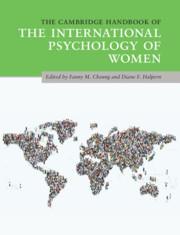Book contents
- The Cambridge Handbook of the International Psychology of Women
- The Cambridge Handbook of the International Psychology of Women
- Copyright page
- Dedication
- Contents
- Figures
- Tables
- Contributors
- Acknowledgments
- Section 1 The Underpinnings of Sex and Gender and How to Study Them
- Section 2 Developmental Perspectives of the International Psychology of Women
- Section 3 Cognitive and Social Factors
- Section 4 Work and Family Issues
- Section 5 Inequality and Social Justice
- Section 6 Health and Well-Being
- Epilogue Some Final Thoughts and Take-Home Messages
- Index
- References
Section 4 - Work and Family Issues
Published online by Cambridge University Press: 20 July 2020
- The Cambridge Handbook of the International Psychology of Women
- The Cambridge Handbook of the International Psychology of Women
- Copyright page
- Dedication
- Contents
- Figures
- Tables
- Contributors
- Acknowledgments
- Section 1 The Underpinnings of Sex and Gender and How to Study Them
- Section 2 Developmental Perspectives of the International Psychology of Women
- Section 3 Cognitive and Social Factors
- Section 4 Work and Family Issues
- Section 5 Inequality and Social Justice
- Section 6 Health and Well-Being
- Epilogue Some Final Thoughts and Take-Home Messages
- Index
- References
Summary

- Type
- Chapter
- Information
- The Cambridge Handbook of the International Psychology of Women , pp. 273 - 372Publisher: Cambridge University PressPrint publication year: 2020
References
Suggested Readings

Alvin Leung Seung-Ming is Dean of Education of the Chinese University of Hong Kong. Born and raised in Hong Kong, he received his doctorate in Counseling Psychology from the University of Illinois, Urbana-Champaign, and joined CUHK in 1996 after serving as a faculty member at the University of Nebraska-Lincoln and the University of Houston. His research focused on career development and assessment, cross-cultural and multicultural counseling, and counseling in educational settings. He is a Fellow of the American Psychological Association (APA) and of the Hong Kong Professional Counselling Association. He received the Distinguished Contributions to the International Advancement of the Counseling Profession Award from the Society of Counseling Psychology of the APA in 2008; the 2009 Distinguished Alumni Award from the College of Education, University of Illinois at Urbana-Champaign; the 2015 Life Time Contribution Award from the International Section of the APA Division of Counseling Psychology; the 2018 Outstanding International Psychologist Award from the APA Division of International Psychology; and the 2018 Award of Outstanding Contribution to the Profession of Chinese Career Development from the 2018 Shanghai Conference supported by NCDA. His co-edited book, International handbook of cross-cultural counseling: Cultural assumptions and practices worldwide received the 2010 Ursula Gielen Book Award from the APA Division of International Psychology. He is a member of several Hong Kong government advisory committees, including the Education Commission and Family Council. He is currently Chief Principal-Investigator of the CLAP for Youth @ JC, a large-scale career development intervention project for Hong Kong students organized by the Hong Kong Jockey Club Charities Trust.

Rachel Gali Cinamon is Full Professor at Tel Aviv University, Israel, where she serves as head of the Career Development Lab, and the post muster career-counseling program, as well as the School of Education. Born and raised in Israel, she attended Bar Ilan University where she obtained her PhD. Her research interests focus on career development of women, minorities and at risk populations, work–family relations through the life span, future plans and perceptions, and career interventions. Her research group involves several university–community partnerships that focus on career interventions in high schools and in civic organizations. Cinamon developed a special and unique career intervention model that emphasizes the importance of being involved in four major roles in order to increase well-being and life satisfaction: work, family, community, and leisure. Her work is driven by her deep commitment to human development and by her belief in her social responsibility for individuals’ health, well-being, and meaningful life. She is a mother of three children, a spouse, a friend, and a long-distance runner.
References
Suggested Readings

Elsa T. Chan is an Assistant Professor in the Department of Management at City University of Hong Kong. Her research interests include entrepreneurship, leadership, and race and diversity. Chen was born in Hong Kong and received her undergraduate degree at the University of Hong Kong. She obtained her MSc in Occupational Psychology from University of Nottingham, UK, and her PhD in Management and Entrepreneurship from Leeds School of Business, University of Colorado at Boulder.

Pok Man Tang is currently a doctoral student in the Department of Management at Texas A&M University. His research interests include behavioral ethics, emotions, proactivity, leadership, and social entrepreneurship. He was born in Hong Kong where he studied for his BA and MPhil in Business at the Lingnan University in Hong Kong. His work has appeared in Organizational Behavior and Human Decision Processes and The Leadership Quarterly.

Shihui Chen is a Lecturer in the School of Business, Ningbo University, China. She was born in China and obtained her PhD from Zhejiang University. During her doctoral studies, she was a visiting scholar at University of Strathclyde in Scotland for one year in 2014. Her primary research interests include female leadership, family firm heterogeneity, and entrepreneurship. Her work has appeared in Asia Pacific Journal of Management, and Science Research Management (in Chinese).
References
Suggested Readings

Rebecca J. Reichard is an Associate Professor of Organizational Behavior at Claremont Graduate University. She directs LeAD Labs, an applied research consulting group focused on leadership development. Her research and practice emphasize the development of individuals with traditionally less access to leadership opportunities, including minorities, women, and LGBT+ individuals. Reichard earned a PhD in management from the University of Nebraska–Lincoln. She is an active member of the Academy of Management and the Society of Industrial/Organizational Psychology, and is the past-chair of the scholarship group for the International Leadership Association. She has published more than 40 journal articles and book chapters on leader development.

Leslie Trainor, MBA, is a doctoral student in Organizational Psychology at Claremont Graduate University and a Research Associate at LeAD Labs. Her research interests are women in leadership and toxic leadership. Trainor concurrently serves as the Deputy Director of the Riverside County Economic Development Agency where she oversees Economic Development, Workforce Development, the Office of Foreign Trade, Marketing, the Office of Film and Television, and several of the County’s nonprofit affiliates. Trainor has been involved in private-sector and public-sector business for over seventeen years and most enjoys helping others become self-empowered. Trainor’s parents were in the military, so she lived in several different countries, with the most time spent in Germany. Her favorite memories of living in Germany include all the wonderful candy at the local Trinkhalle, Volksmarching with her family, and eating freshly baked Brotchen. At her current job, she regularly hosts delegations from other countries and finds the variety of cultural norms to be completely fascinating

Krista Lynne Jensen is a doctoral student studying Positive Organizational Psychology and Women’s Studies at Claremont Graduate University. Her research focuses on taking an intersectional approach to understanding and facilitating the development of women leaders. Specifically, Jensen is interested in identifying, testing, and implementing evidence-based organizational intervention strategies to address barriers to women’s leadership development. Jensen graduated from Santa Clara University, California in 2014 with a degree in Psychology and a minor in Anthropology.

Inmaculada Macias-Alonso is a Research Fellow at the Women and Public Policy Program at Harvard Kennedy School. Her research focuses on the effects of sex and gender on the quantitative and qualitative content of feedback. Her most recent work contrasts the “think-manager-think-male” phenomenon with the “female leadership advantage” through the examination of leadership feedback provided to men and women. Macias-Alonso holds a PhD and MSc in Organizational Behavior from IE Business School (Spain), an MA in Area Studies from Leiden University, a BA in Political Science from Universidad Nacional de Educación a Distancia, and a BA in Middle Eastern & Arabic Studies from Universidad Autonoma de Madrid. She has been a visiting lecturer at CESA School of Business in Bogota, a visiting graduate student at the Netherlands-Flemish Institute in Cairo, and an undergraduate exchange student at George Washington University in Washington, DC.
References
Suggested Readings

Oi-ling Siu is Chair Professor and Dean of Faculty of Social Sciences, Lingnan University, Hong Kong. She attended University of Strathclyde for her undergraduate degree, University of Hong Kong for her AdvDipEd and master’s degree, and University of Liverpool for her PhD. Her research interests include occupational stress, work–life balance and psychology of safety. She is one of the Top 25 work–family scholars in the world (Google Scholar, May 2017) and was awarded 2018 “Top 50” overall contributor to work and family research by Work and Family Researchers Network, Washington, DC. Siu is the Editor of International Journal of Stress Management and Associate Editor of Journal of Occupational Health Psychology.

Hai-Jiang Wang is an Associate Professor at the School of Management, Huazhong University of Science and Technology. Born in Shandong Province, he attended Zhengzhou University for his Bachelor of Engineering Peking University for his master’s degree in Industrial and Occupational Psychology, and Eindhoven University of Technology Netherlands for his PhD. He has worked in Lingnan University in Hong Kong for two years, and visited University of Verona for a month. His research areas include job design, work stress, and leadership. He is an editorial board member of the International Journal of Stress and Management.

Milan Pagon is a Pro-Vice Chancellor at the Independent University, Bangladesh (IUB) in Dhaka. He holds an ScD in Organizational Sciences (Human Resource Management) from the University of Maribor, Slovenia where he was born and raised, and a second PhD in Business Administration (Management/Organizational Behavior) from the University of Arkansas, Fayetteville, as a Fulbright Scholar. His research focus is on human resource management. Pagon has worked in Europe (Slovenia, North Cyprus, and Italy), the United States, and the United Arab Emirates, and has been living and working in Bangladesh for the last five years.
References
Suggested Readings

Ujvala Rajadhyaksha is Associate Professor in the College of Business at Governors State University in the United States. She has held full-time faculty positions at Saint Mary’s College, Notre Dame, Indiana, the Indian Institute of Technology, Bombay and the Indian Institute of Management, Calcutta,. Her research interests include work and family issues, gender issues and intercultural and cross-cultural issues in management. She has been a collaborator on three large-scale cross-cultural W–F studies. Her research has been published in Human Relations, Sex Roles, Journal of Business Ethics, Journal of Management Education, and Applied Psychology and Organizational Dynamics. Ujvala deeply identifies with the topic of dual-earner couples with her personal experience of juggling work and life in tandem with her husband across three countries and multiple cultures. Her doctoral dissertation was a study of the work–family conflict of dual-career couples in India across the work–family life cycle. One of her thesis publications was nominated for the Rosabeth Moss Kanter Award for Work and Family Research in 2001. Ujvala was born and raised in Mumbai. She attended college and graduate school in India. She has lived and worked in India, China, and the United States, and spent a semester in Canada on the Shastri Indo-Canadian Fellowship.

Burcin Baskurt has a PhD in Social and Organizational Psychology from Koç University, Istanbul. She earned her BA in Sociology at Bogazici University and her MA in Comparative Studies in History and Society at Koç University. Her doctoral research concentrated on career decisions of young people in Turkey and antecedents of career change intentions of young employees. Her main areas of research include interrelations between gender, work, and education. She has been working in various national and international research projects, including career tracks of social sciences and humanities PhD graduates, success definitions of entrepreneurs, positive development of early adolescents, and fears of women and men in leadership positions. She has journal publications, book chapters, and conference proceedings on these different topics. She received the Graduate Studies Excellence Award from Koç University and the Crosby-Spendlove Award from SPSSI in support of feminist perspective and social justice. Baskurt was born in Istanbul, where she attended college and graduate school. She spent a semester in her senior year in Michigan. She has been living in London since June 2018.
References
Suggested Readings

Ahva Mozafari is a doctoral candidate in the Clinical Psychology program at Idaho State University. She received her BSc in Psychology from Boise State University and her MSc in Clinical Psychology from Eastern Washington University. Her research interests include romantic relationships, shame, attachment, and culture. A large portion of her clinical work has been in community mental health with refugees as well as with US-born adults, children, and adolescents. She has also worked with couples and families. Mozafari was born and grew up in Boise, Idaho. Her parents are immigrants from Iran, and she has spent several summers there throughout her life. She identifies as a first generation Iranian American.

Xiaomeng (Mona) Xu is an Associate Professor of Experimental Psychology at Idaho State University. She received her BA in Psychology from New York University and her MA in Psychology and PhD in Social Health Psychology from Stony Brook University, and she completed a postdoctoral Research Fellowship sponsored by the National Institutes of Health at the Warren Alpert Medical School of Brown University and the Miriam Hospital. Xu and her lab conduct both basic and applied research on romantic relationships, behavioral health, neuroimaging, and pedagogy. She was born in Fuling, a district of Chongqing Municipality in China and grew up in the United States. She conducted collaborative research in Bejing. She identifies as an immigrant.
References
Suggested Readings

Mzikazi Nduna’s career began in 1995 as an educator and she has since worked as a trainer, advocate, and researcher of sexual and reproductive health and rights for women and young people. She currently works as an Associate Professor in the Department of Psychology at the University of the Witwatersrand. Nduna’s work covers the global South from Nicaragua to Fiji and the Solomon Islands outside the African continent and includes a research study on parenting practices in Bangladesh. She has worked in different countries across sub-Saharan Africa. Her research outputs include 60 peer-reviewed journal articles, three special issues, six book chapters, one edited book, and a number of research reports. On Google Scholar, Nduna has 4,661 citations and an H-index of 25. She also communicates her research findings through non-academic platforms such as mainstream and social media and uses her research knowledge to contribute to workshop interventions and training manuals.

Sibusiso Mkwananzi is a Senior Researcher at the Centre for Social Development in Africa, University of Johannesburg. Mkwananzi hails from a mixed ethnic background of Ndebele, Xhosa, and Sotho. She was born and spent her childhood in Zimbabwe, before relocating to South Africa. Mkwananzi’s qualifications span a PhD in Demography, a master’s in Epidemiology and Biostatistics, postgraduate qualifications in public policy and analysis, project management, marketing management, and employee health and wellness, as well as an undergraduate degree in Dentistry. As a methodologist, her research interests lie in the application of quantitative research methods to contextual analysis of phenomena as well as traditionally qualitatively approached research on gender, intersectionality, sexual and reproductive health and rights, race, youth studies, and the nexus of social and health occurrences. Mkwananzi was a recipient of the National Research Foundation Innovation and Scarce Skills Fellowship, the Oppenheimer Memorial Trust Foundation Scholarship, and the South African Humanities Deans’ Association Fellowship. She is currently involved in international collaborative research projects encompassing adolescent risk perception as well as the contextual appraisal of gender-based violence and sexual and reproductive health and rights.

Naomi Netsayi Wekwete is a Senior Lecturer at the Centre for Population Studies, University of Zimbabwe. She has a PhD in Applied Population Research from the University of Exeter, and an MSc in Population Studies and a BSc in Economics from the University of Zimbabwe. She has won several research awards and has vast experience in conducting policy-oriented research. Her key research areas are adolescent sexual and reproductive health, and gender and population. Wekwete has been actively involved in gender advocacy activities with the Zimbabwe Gender Budgeting Network. She is the UZ coordinator of the Young Women Leadership in Sexual and Reproductive Health and Rights project since 2010, a project within seven southern African universities with the aim of empowering female students with research and leadership skills and improving their sexual and reproductive health lives. She has various publications in her area of expertise, including “The association between spousal gender based violence and women’s empowerment among currently married women aged 15–49 in Zimbabwe: Evidence from the 2010–11 Zimbabwe Demographic and Health Survey.”

Matamela F. B Makongoza is a PhD student and a teaching assistant and holds a master’s degree in Research Psychology from the University of the Witwatersrand. Matamela’s research interests are in sexual and reproductive health and rights, gender and gender-based violence, and HIV/AIDS. She is part of the WITSIE (Women Intellectuals Transforming Scholarship in Education) research team at WITS University. The research team empowers young woman through research skills to conduct scientific research and publications. This research team is comprised of academics, mentors, and postgraduate students of WITS. She has co-authored six peer-reviewed journal articles and one media article, and has presented in local and international conferences.



